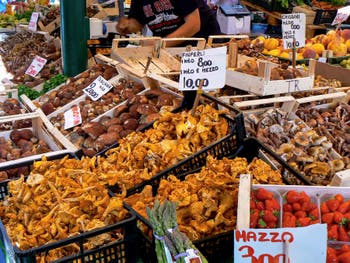Shopping Food Drink | Fashion | Carnival | Books | Glass Beads Jewels | Art Objects | Useful
Food Drink Rialto Market | Pasta | Ice Cream | Coffee Roaster | Charcuterie Cheeses | Wine | Pastry
Rialto Market Pescheria Fish | Erbaria Fruit Vegetables
The Erbaria Market, or Erberia, the Fruit and Vegetable Market at Rialto in Venice
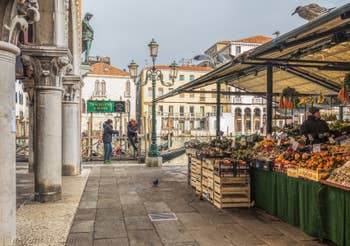
The Erbaria at the Rialto Market When we talk about the Rialto market, we're not talking about one but three very different markets.
The best known is the Pescheria (or Pescaria), the fish market.
The second is the Erbaria (or erberia) market along the Grand Canal, between the Fabriche Nove and the Pescaria. This is the fruit and vegetable market.
The last is the Beccaria (or beccarie or beccherie) which is the meat market.

Rialto Market in Venice: the Erberia. It all began in 1097 when two wealthy Venetians, Pietro and Tiso Orio, donated a huge plot of land that included shops and warehouses to the Republic of Venice.
The Venetian authorities, who became the owners of this area located in the heart of the city's main centre of activity at the time, then took charge of the development and expansion of commercial activity in this part of the Rialto district.
And the food trade was only part of it, as the Rialto was also the city's banking centre in the Middle Ages.
But what interests us here is the Erbaria market, still very active several centuries after its creation!
It is not known exactly when the Erbaria (or erberia) fruit and vegetable market began in the district, but there are written records of its existence as early as the 13th century.
Marin Sanudo, wrote about the Erbaria in 1493:
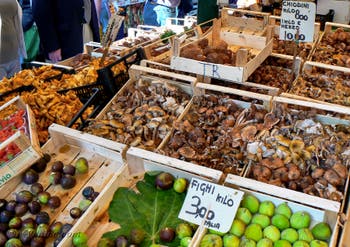
Rialto Market in Venice: the Erberia
"In this town where nothing grows, you can find anything you want in large quantities.
And that's because of the rapid flow of goods; everything arrives here, especially victuals from cities all over the world [...]
Here, at the Rialto, it's like in a vegetable garden, they sell great varieties of fruit and so cheaply that it's wonderful."
Marino Sanudo
And if you're passing through the Rialto district in Venice in the morning, you absolutely must stop by the Erbaria to fill your eyes with colours, intoxicate yourself with smells and listen to the Venetian language sing there.
Shortly after Marino Sanudo, in 1550, it was Pietro Aretino known as L'Arétin, who was then living in the Palazzo Bolani (now destroyed), just next to the Rialto markets, who describes the spectacle he could admire from his window:
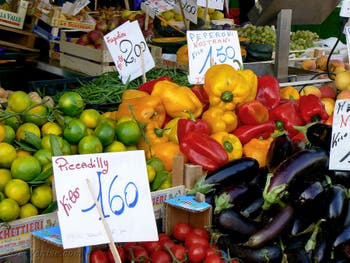
Rialto Market in Venice: the Erberia
"So I can truly say that I enjoy the most beautiful street and the busiest view in the world.
I can't stand at the window without seeing thousands of people and as many gondolas at market time.
On the right, the view takes in the Campo delle Beccarie and the Pescheria; on the left, the view takes in the bridge and the Fondaco dei Tedeschi; at the intersection of the two, the Rialto is crowded with merchants.
For me, there are vines on the barrows, game in the shops, and vegetable gardens on the ground.
I don't mind the streams watering the meadows when at dawn I see the water covered with all sorts of seasonal produce.
What a lovely pastime, the merry-go-round. What a lovely pastime, the merry-go-round of conveyors distributing heaps of fruit and vegetables to the porters who carry them!"
Pietro Arétino (1492 - 1556) - Letters of the Arétin
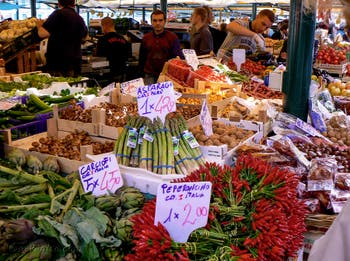
The Rialto Market in Venice: the Erberia
L'Erberia: Mountains of Turnip Cabbage and Salads!
"There were mountains of cabbages, turnips and salads on the shore near the Rialto that day.
The fruit market and the fish market were overflowing; the merchants were shouting, the buyers were gesticulating.
Nothing so strange as these popular scenes suddenly spreading out between two fairytale palaces."
Louise Colet - The Italy of Italians 1862
A feast for the eyes, a pleasure for the ears
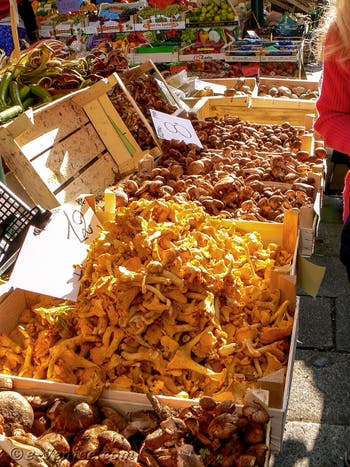
Rialto Market in Venice: the Erberia
"Onions in strings adorn the arcades of the square with their graceful festoons, while, on rustic tables, asparagus, broccoli, yellow lettuce and pink carrots alternate with baskets full of oranges, round apples, tomatoes and lemons, which cheerfully reflect the sun's rays and gild the surrounding houses with their beautiful reflections.
Strawberries, cherries, apricots and peaches lie side by side with prickly pears, green melons, dates, watermelons and muscat grapes.
It's a feast for the eyes as well as a pleasure for the ears; for there's something musical about the Venetian babble of all these cheerful gossips, which makes it sound like the chirping of a flock of birds."
Henry Havard - Amsterdam and Venice 1876
A market as sonorous and fresh as shellfish
"To so much subtle refinement, the buildings of the "Pescheria" and "l'Erberia" contrast the simplicity of their arcades, which house, on the other side of the canal, the fish, fruit and vegetable markets supplied by boats from the Lido and the islands.
Colour here is natural.
It's on an autumn morning, when the pinasses disappear under their load of blue grapes, russet peaches and glowing peppers, that you have to wander through this market and also the whole Rialto district, as sonorous and fresh as one of those shells where you can hear the rumour of the sea."
André Fraigneau - Venice that I love
Fruit as fiery as precious stones
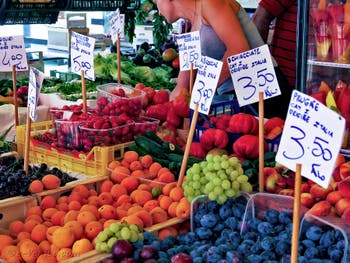
Rialto Market in Venice: the Erberia
"Those of the fruit trees offer the most splendid displays; nothing is fresher, better grouped, more appetising than these heaps of ruddy peaches arranged like cannonballs in artillery parks, than these masses of golden, amber, transparent grapes, coloured in the richest colours, as fiery as precious stones, and whose seeds, strung into necklaces and bracelets, would admirably adorn the collar and arms of some young ancient Maenad.
Tomatoes mingle their violent reds with these blond hues, and the watermelon, splitting its green corset, reveals its pink wound.
[...] One cannot treat the eyes more pleasantly, and often, without the slightest hunger, it has happened to us to buy these peaches and these grapes for the pure love of colour."
Théophile Gautier - Italia 1855
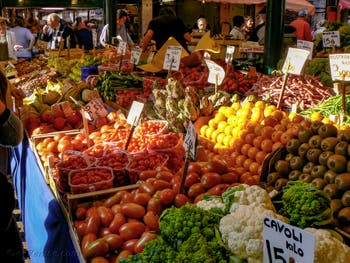
Rialto Market in Venice: the Erberia
Heaps of tomatoes, chillies and aubergines
"I liked, he wrote, to go there early in the morning, at the hour when the big peote unload the market garden produce there from Terre Ferme.
Nothing seemed more beautiful than the heaps of tomatoes, peppers, aubergines and fennel.
The sight of watermelons delighted me. The boats were loaded to bursting."
Henri de Régnier
Casanova goes to the Erberia one morning to calm down...
"Sure of receiving money the next day, I spent the night gambling, and lost five hundred sequins on my word.(The extract quoted above takes place on 24 July 1755, the day before his arrest)
At daybreak, needing to calm my nerves, I went to the Erberia, a place on the quay of the great canal that runs through the city.
This is the market for herbs, fruit and flowers.
The Rialto Market in Venice: the Erberia People in good company who go for a walk to the Erberia early in the morning are agreed to say that it is to enjoy the pleasure of seeing hundreds of boats loaded with vegetables, fruit and flowers arriving from the many islands around the city.
But everyone knows that it is only the young men and women who have spent the night in the pleasures of Cythera, in the excesses of the table, or who, despairing of fortune and victims of imprudence, have lost their last hope in gambling, who go to this place to breathe freer air and calm their agitation.
The taste of this walk proves how much the character of a nation can change.
The Venetians of yesteryear, as mysterious in gallantry as in politics, are obliterated by the moderns, whose predominant taste is to make a mystery of nothing.
The men who go in the company of women want to arouse the envy of their equals by flaunting their good fortune.
Those who go alone are looking to make discoveries or arouse jealousy: the women hardly ever go except to be seen, quite happy for everyone to know that they don't mind.
The Rialto Market in Venice: the Erberia Besides, there can be no question of coquetry here, given the dilapidated state of the finery.
It would seem, on the contrary, that the women have taken it upon themselves to show themselves there under the signs of disorder, in order to provide those who see them with matter for conjecture.
As for the men who give them their arms, their lack of care and their air of nonchalance should show the boredom of a worn-out complacency and make one guess that the disorder of their companions is the proof of their triumph.
Lastly, it is a sort of good form at this morning walk to look downcast and show the need to go to bed.
This very true description, my dear reader, will not give you a very high idea of the morals of my dear fellow citizens; but at my age why shouldn't I be true?
Besides, Venice is not at the end of the world; it is a place that is fairly well known to foreigners whose curiosity attracts them to Italy; and everyone can tell whether my paintings are loaded."
Giacomo Casanova - Memoirs of my life 1822
Rialto Market Pescheria Fish | Erbaria Fruit Vegetables
Food Drink Rialto Market | Pasta | Ice Cream | Coffee Roaster | Charcuterie Cheeses | Wine | Pastry
Shopping Food Drink | Fashion | Carnival | Books | Glass Beads Jewels | Art Objects | Useful
Back to Top of Page


